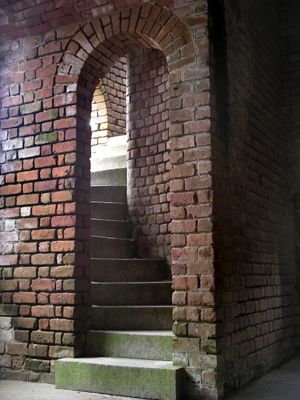 by thousands of footsteps; the intricate mosaic of tiles forming circular bases for the cannons.
by thousands of footsteps; the intricate mosaic of tiles forming circular bases for the cannons.
 behind those amazing places, I certainly appreciated their current state and reveled in exploring them. Forts I have enjoyed include Fort Morgan in Alabama, and Fort Pickens, Fort Clinch, and West Martello Tower in Florida.
behind those amazing places, I certainly appreciated their current state and reveled in exploring them. Forts I have enjoyed include Fort Morgan in Alabama, and Fort Pickens, Fort Clinch, and West Martello Tower in Florida.
The heavily fortified brick structures were made to not only withstand enemy attacks but also the elements themselves. It is obvious that the sandy shores of our Atlantic and Gulf coasts are not good locations on which to build anything that should last more than a few years. Shifting dunes, salt air, waves, and the periodic hurricane can definitely test any structure's integrity. I think one of the appealing aspects of an old fort is that it is so out of place: a strong, solid edifice in an ephemeral environment.
Entering a place so oversized and, well, rocky, is always a bit like entering a cave. The bright sun and hot temperatures of the beach are kept at bay by massive archways, long tunnels, and dark rooms. There are myriad rooms and passageways, some small and claustrophobic, or even secret, and others large and majestic. The big difference between the outer dimensions and the inner (with walls often several feet thick) can be disconcerting to one's sense of proportion. Sometimes narrow stairways up sheer walls, tall garrets, and maze-like connections between inner rooms give the entire place a surreal atmosphere. There is also a delightful mix of large and small aspects. On the one hand, the huge scale of a fort is downright impressive. A person can feel dwarfed standing in the midst of those colossal walls. But within, there are all sorts of small details. Any number of surprises are waiting to be discovered: the little lichen and moss gardens growing between the bricks; the stone stairs smoothly worn  by thousands of footsteps; the intricate mosaic of tiles forming circular bases for the cannons.
by thousands of footsteps; the intricate mosaic of tiles forming circular bases for the cannons.
When my sister and I were very young, we liked to imagine how we would create a home within the fort. We'd enter a large room that would be the entertainment center, a cozy nook for a bedroom, or an oddly shaped space that would be the kitchen. The best part was deciding where we would put the gardens, since forts tend to be a combination of indoor and outdoor spaces. When I first saw West Martello Tower in Key West, it was like a dream come true: the Key West Garden Club had actually turned the entire fort into a walled garden!
In spite of my lack of interest in history, some stories about the forts were just too compelling to forget. One that obviously made quite an impression on my young brain had to do with Fort Morgan, if I remember correctly. The cisterns, which contained fresh water, were breeding grounds for fleas. Their population became so great that they emerged en masse and covered everything, making life nearly unbearable for the soldiers living there. Now that is certainly a nightmare scenario! Another story, from one of the Florida forts, was that there was a permanent bloody hand stain on one of the stairs. I remember trying to discern which dark blotch might be this mythical sign left by a dying soldier so long ago.
More recently, I have found the forts to be a photographer's paradise. The graceful arches and tunnels defy their utilitarian purpose, becoming works of architectural art. Twisting staircases, narrow gun slits, and walls reminiscent of medieval castles kindle the imagination. The interplay of light and shadow ranges from dramatic to spiritual. Decay and permanence interact in fascinating ways. Playing with my digital camera, I have found myself drawn into studying a fort's viscera for much longer than I would have on a quick guided tour.